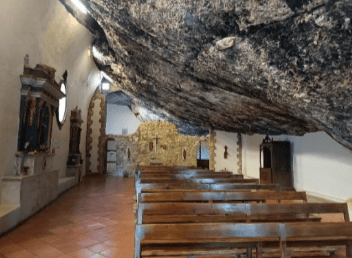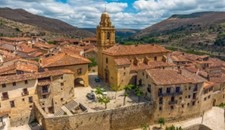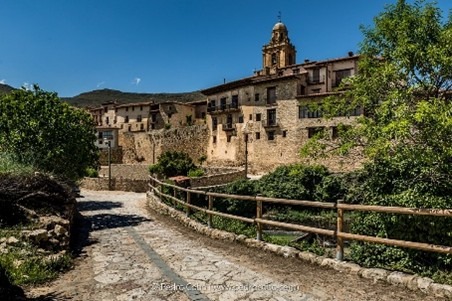Tuesday 13th – Friday 16th May 2025

After leaving Jávea we will travel to Culla, with free time for refreshments and to wander through the historic centre, where the Templars left their mark. Culla still preserves its medieval atmosphere in its old town, partly surrounded by impressive walls and designated a Site of Cultural Interest.

The different alleys and small squares seem to guide visitors to the church of the Saviour (18th century). The old Granary of the Knight Commander (13th-14th centuries), referred to as La Presó, is also well known: it was used as a prison during the Carlist Wars in the 19th century. The castle was destroyed during the wars but has now been partly rebuilt and the outside can be visited through the arch of the Porta Nova (rebuilt in the 17th century).
We will then reboard our coach and travel to Cantavieja, the historic capital of Alto Maestrazgo, and check in to the 4* Hotel Spa Balfagón Alto Maestrazgo for 3 nights bed & breakfast accommodation. Awarded the prize for tourism merit, it reflects a combination of contemporary and traditional style, maintaining the strong personality of the area based on natural materials, such as stone and wood. It is only a short walk from the centre of Cantavieja. Dinner included on the first evening.

Wednesday 14th May
After breakfast we will travel to nearby Fortanete for a guided walking tour, seeing its old municipal jail; the House of the Dukes of Medinaceli, a noble house from the last third of the 16th century, with three floors ending in large wooden eaves in the style of the Renaissance palace-houses throughout the Maestrazgo; and the 16th century Town Hall.

After our visit we will return to Cantavieja, which features not only splendid monumental and architectural heritage, but also the echoes of ancient legends and battles. Its historic quarter has the Property of Cultural Interest designation.

The town has one of the most complete monument ensembles of Aragonese Gothic. The ruins of its old castle preside over the town. The castle was destroyed during the I Carlist War: Cantavieja was the command centre of the Carlist general Ramón Cabrera, the “Tiger of Maestrazgo”. There are narrow streets and medieval-looking houses and in the Plaza Mayor you can find the Town Hall, with the Gothic coffered ceiling of its Plenary Hall, and the Church of the Assumption (18th century). Other buildings of interest include the Gothic church of San Miguel, the old Baroque hospital of San Roque and manor houses such as Casa Bayle, Casa Novales and Mas Fortificado.

The time will be free for sightseeing, lunch, and to make your own way back the short distance to the hotel when ready.
Evening free.
Thursday 15th May
After breakfast we will travel to Tronchón and visit the Queseros Artisanos, a family-run cheese factory which produces the famous Tronchón cheese as it did in the past. But the ingredients remain the same: perfectly controlled raw goat or sheep milk, which only needs rennet and salt and a curing time. The milk does not undergo high heat treatments, thus keeping the local flora intact to give the cheese its particular and intense flavour and aroma, as well as a good bouquet and aftertaste.

Free time for coffee and to explore its historic centre where you will find important architectural buildings such as the church of Santa María Magdalena, the Town Hall, which is a Renaissance building from the 16th century, the Palace of the Marquis of Valdeolivo and the old Gothic prison building, built in the 14th century.

We will then make our way to Zorita del Maestrazgo, a mountainous region with large pine and holm oak forests. Lunch is included for the group at the onsite restaurant followed by a visit to the Santuari de la Mare de Déu de la Balma, declared an Asset of Cultural Interest and Historic-Artistic Monument, which is embedded in the hollow of a huge mass of rock.


Although there is evidence of the sanctuary as early as the 14th century, the current one was built in 1667. Next to the church building itself, there is a guest house with a restaurant open to the public, and access to the gallery leading to the sanctuary is via this last building. The room through which it is necessary to pass has been transformed into a small museum. Note that the coach will have to stop at the bottom road, so there will be an uphill walk and steps in order to carry out the visit.

On the return journey to Cantavieja we will have a stop at Mirambel. Often referred to as “a jewel within the walls”, Mirambel is included in the list of “Most Beautiful Villages of Spain”.



In 1980 it was declared an Historic-Artistic Site for being “a town steeped in history, fully conserving the walled enclosure and notable buildings, without altering the image and medieval atmosphere” and, the following year, it was awarded the Gold Medal of the Europa Nostra prize for the restoration and development work on the town’s urban complex, which was presented to it personally by Queen Sofia.
Return to our hotel and free evening.
Friday 16th May
After breakfast we will check out of the hotel and make our way to La Iglesuela del Cid, one of the landmarks of the Maestrazgo. The town experienced a long period of economic prosperity in the past, which has given it beautiful examples of civil and religious architecture. The excellent conservation of its urban centre earned it the title of Historic Artistic Site, with its lovely Plaza Mayor standing out. Here you will find the Town Hall, the church of the Purificación and the Matutano-Daudén palace (now a hotel).

There will be a guided walk through its streets, some of which may be cobbled (45 mins), ending with a visit to the Aliaga house, touring all the rooms to see and understand how the nobility lived in rural areas from the sixteenth century to the twentieth century.

– The first floor with the typical pebbled floor, drawing attention to a wall clock with hands with 24 hours a day.
– The second floor was the place of residence of the landlords. It has a living room with a fireplace, entertainers at the windows, a curious office with a secret staircase, clothing and accessories. In addition, a kitchen renovated in the 50’s with all its utensils.
– The second floor was the place of residence of the lords, with its large wooden coffered ceiling, the living room with beautiful curtains, a showcase with curious antique toys, the main living room, where the high society used to meet, the old kitchen with its large fireplace and numerous utensils, a room with a bathroom when in the town bathrooms did not exist yet, another master bedroom with a bed emblazoned and a modernist room with curious details.
– The Tourist Office is located in the stables.
After free time for coffee we will continue our return journey to Jávea, stopping for lunch enroute at the Restaurante Rosildos.
If you would like to receive the detailed programme and cost when finalised, please send an email to the group leader, Angela Chantry:
spanish.culture.cuisine@u3ajavea.com (please copy and paste into your mail provider).



